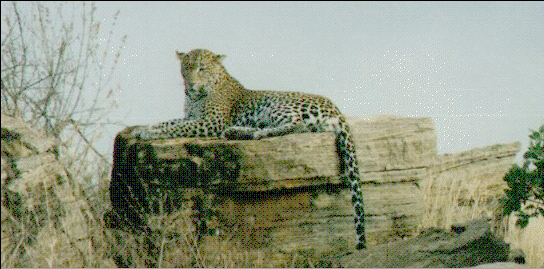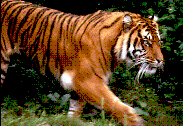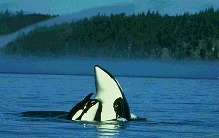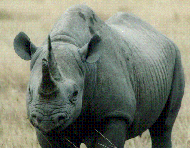Exotic Animals

General Disclaimer
This Web project was developed as part of "Internet Resources" courses offered by the Biology and Geology departments of the California State University, Los Angeles in 1995 and 1996. It was submitted to the instructors for evaluation and then placed on-line by the Electronic Desktop Project (EDP). EDP does not update or maintain any of the material of this project, and does not vouch for validity or correctness. Furthermore, the student developing this project was instructed about the rules of copyrights. EDP can in no way be responsible for the inclusion of copyrighted material within this project.
Welcome to the exotic animals website where you will get a glimpse at some beautiful species from various habitats. You may also fill free to click on any of the links to travel to museum and specialized sites on any particular animal. I hope this site will be both entertaining and informative to you.

Tiger
An image of the tiger can almost define "Exotic Animals" in itself because the tiger is as rare as it is elegant. Tiger is native to the continent of Asia. The scientific name of the tiger is Leo tigris, known to be the largest cat. The coat of a tiger is often bright orange with black stripes to camouflage with the dense jungle. Most cats, including the lions, originated from the jungle and at one time or another have stripes on their body. Lions and cheetahs still retain some of their "tiger" stripes on their belly. Visit Tiger Town to get more information and images of tiger.

Killer Whale
Again, we have another exotic animal that is largest in its family. The killer Whale (Orcinus orca) is the largest of the dolphin family. The male killer whale can measure up to 7m and weigh 4-5,000 kg and a female measures about 6.6 m and 2.5-3,000 kg. The Orca has one of the most varied diets of all whales. However, despite it's name, the killer whale has never been recorded to hurt a person in the wild. The Orca mostly prefer to feed on salmon, cod and squid. Killer whale is also unique in another sense in that they stay together in a close knit family group, call pod, for life. You can go to Sea World for complete information and a film clip on killer whales.

Rhinoceros
The Rhinoceros belongs to the exotic animals list by every means and even more so because all of its species are threatened, some are even close to extinction. Regardless of protective laws people are still killing them for medicinal value and for their horns, which is believed by some to be an aphrodisiac. Most rhinoceroses live in open grassland, scrub forest and the Savanna. Measuring 4.3 meter long and weigh as much as 4 tons, the rhinoceros feeds mostly on a variety of vegetation: grass, reeds and twigs. Male rhinoceroses during breeding season, and female with calves, can be violent and charge at you. The scientific name for the black rhinoceros is Diceros bicornis.

Bald Eagle
The symbolic bald eagle not only represents our Nation but it also reminds us of how close we came to wiping out an exotic bird. The bald eagle's population greatly improving in number and productivity in recent years. In the early 1960's the bald eagle (Haliaeetus leucephalus) was nearly extinct, largely due to widespread use of DDT which poisons the fish that the eagles prey on. Since then congress passed Environment protection laws and Bald Eagle Protection Act to ensure the existence of the bald eagle. More information and images of the bald eagle are at American Bald Eagles
Looking for a particular animal? Infoseek Animals will allow you to search for all kind animal.
Visit the Exotics Sanctuary, an organization dedicated to protect endangered animals.
If your are an animal lover and want to see some more animal images, click Animal frame.
See my cat Morpheous taking a nap.
Bibliography
 Ben Lee
Ben Lee
The following has been added by the Electronic Desktop Project:
 Contact Us
Contact Us
Please take a few minutes to send us your comments and suggestions. We read every message and try to respond promptly to questions. Your feedback will help us improve our project.
If you are an educator who is using our NEXTSTEP or virtual applications in the classroom, we would especially like to hear from you. Let us know what you are doing and how it is working out. Continued support for this project will depend on its impact in science education.
If you are an educator who is interested in making use of our NEXTSTEP or virtual applications, please let us know how we can help.
Other Places To Go
 Return to the Electronic Desktop Project home page
Return to the Electronic Desktop Project home page
 Check out the WWW Virtual Application Catalog from the EDP
Check out the WWW Virtual Application Catalog from the EDP
 Check out the NEXTSTEP Application Catalog from the EDP
Check out the NEXTSTEP Application Catalog from the EDP
 Visit the home page for California State University, Los Angeles
Visit the home page for California State University, Los Angeles


 Ben Lee
Ben Lee
 Contact Us
Contact Us Return to the Electronic Desktop Project home page
Return to the Electronic Desktop Project home page![]() Check out the WWW Virtual Application Catalog from the EDP
Check out the WWW Virtual Application Catalog from the EDP Check out the NEXTSTEP Application Catalog from the EDP
Check out the NEXTSTEP Application Catalog from the EDP Visit the home page for California State University, Los Angeles
Visit the home page for California State University, Los Angeles